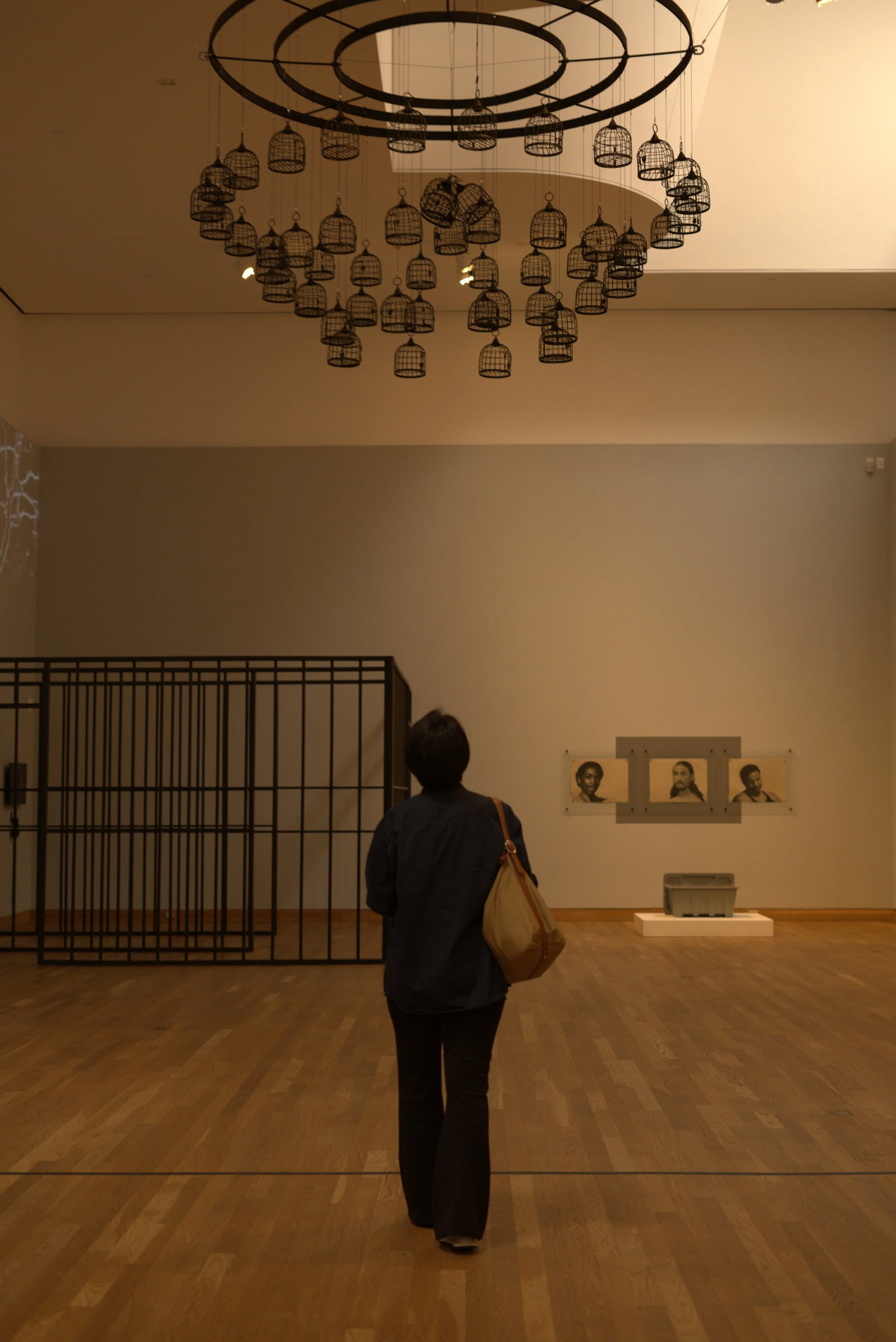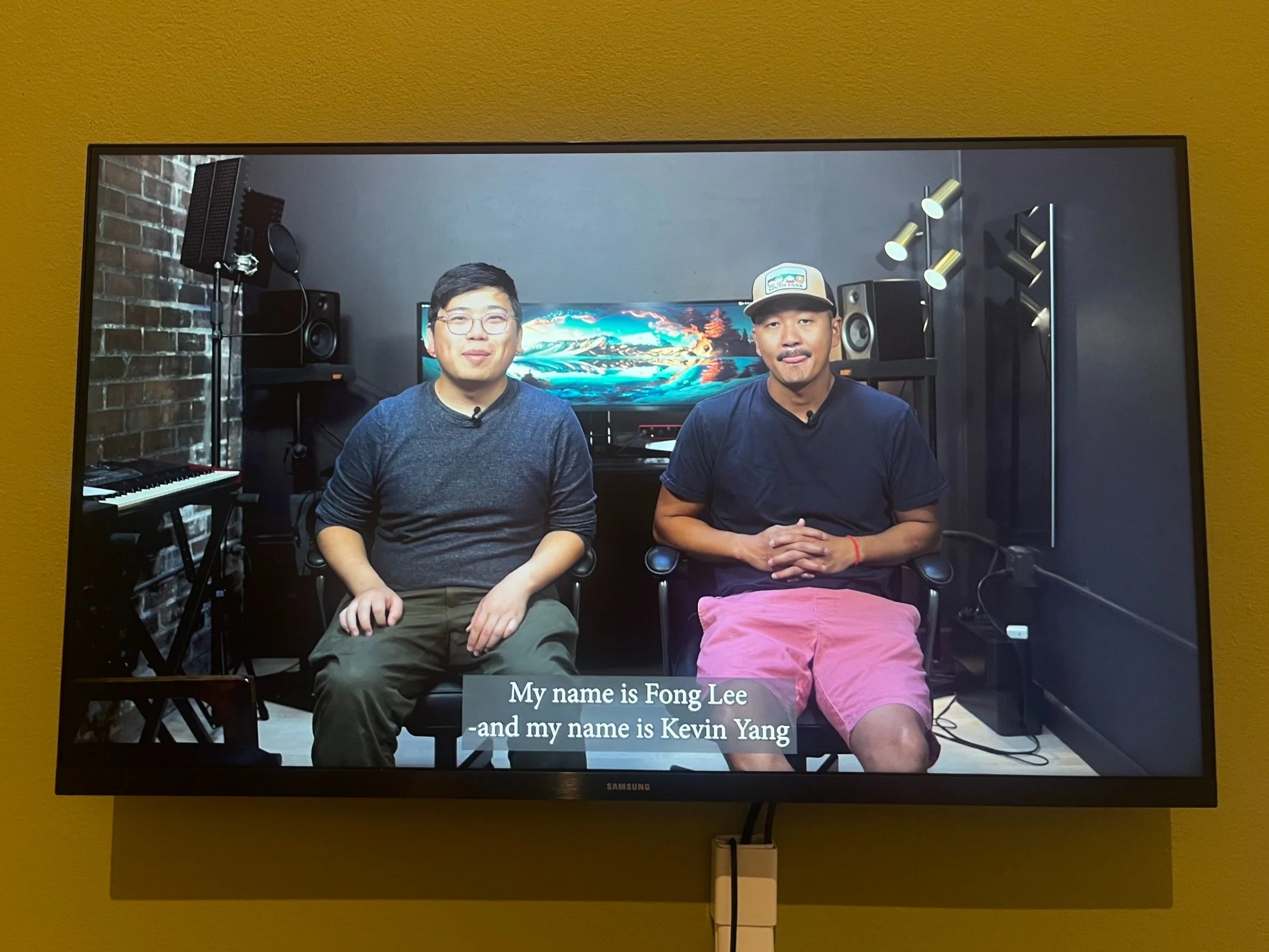Seen and Unseen: Identity, Resistance, and Visibility @Weisman Art Museum, Minneapolis
In honor of Asian American and Pacific Islander (AAPI) Heritage Month, Asian Voices Europe visited SEEN, an exhibition by We Are All Criminals (WAAC), which amplifies the voices of those often erased from narratives around criminal justice, identity, and belonging. We spoke with Kevin Yang, one of the collaborating artists, to learn about the processes and history behind this group show. A special thank you to Emily Baxter, director and one of the founders of WAAC, for guiding us at the exhibition.
Lily and Hyunjung from Asian Voices Europe standing in front of the SEEN exhibition.
SEEN reveals what’s long been hidden and celebrates what needs to be made visible. Coordinated by Emily, the exhibition provides a space for incarcerated artists and activists to explore the themes of incarceration, isolation, intergenerational and postwar trauma, belonging, and homecoming. It’s a collective effort shaped by artists, activists, and scholars in Minnesota.
Hyunjung at the SEEN exhibition.
Installation by Sarith Peou and Carl Flink, Cage(d), 2024, mixed-media installation.
The exhibition unfolds across two themes—inside and outside. The inside space, designed in stark industrial gray, gives voice to incarcerated artists grappling with isolation and trauma from war, genocide, and poverty. The outside space, by contrast, is warm and colorful, evoking the feel of a garden lush with healing, togetherness, and collective action. In the garden space, artists Kevin Yang and Fong Lee present While We’re All Still Here, which centers around a ritual of care and intimacy to let people feel that they belong and feel that they are connected to one another.
A still from a video by Kevin Yang (left) and Fong Lee (right).
While We’re All Still Here, 2024, mixed-media installation
We spoke with Kevin to deepen our understanding of his work and experiences as part of the Asian diaspora in the U.S. (The Interview excerpts below have been edited with the Kevin’s permission).
AVE: Could you briefly introduce yourself?
Kevin: I’m a multidisciplinary artist. I do spoken word poetry, filmmaking and organisational work. I have a long history in my community as an arts worker, arts creator, and educator.
AVE: How did you become involved with the SEEN exhibition and how did While We’re All Still Here come about?
Kevin: Emily reached out in 2020, inviting me to collaborate with Fong Lee. Early on, we weren’t focused on a project. Rather, we were just sharing our lives, our poetry, our art. That human connection became the heart of the collaboration. First couple of years while Fong was still incarcerated, we really talked through not even necessarily from a project standpoint, but about the different things in our lives that were important for us and what we've been working on.
Emily sent me a lot of Fong's poems and his paintings early on and I had a chance to send some of my poetry over too, which is one of the things that I value the most out of this project. This partnership was a chance to get to know Fong as a person. But really getting to know this other person, having that chance to see each other as artists, as human beings, was really, really heartwarming. This project is built out of many, many years of relationship building, a trust building of getting to know each other.
A still from the Khi Tes ritual by Kevin and Fong
AVE: How do you think art can challenge dominant narratives and offer healing or solidarity?
Kevin: Healing has been central to the art Fong and I created together. At the heart of our project was a poem Fong had written when his father and his uncle passed away from COVID, during his time incarcerated. Fong shared his difficulty being separated from two people who meant a lot to him and trying to find space to grieve, to care for other people, to feel like you're being cared for and to heal. We wanted to create a space where we could see each other and where we could let each other know that we care.
When we were brainstorming how we could activate those feelings in the space of the exhibit, we came to the concept of a Hmong ritual, since both of us are Hmong. Together, we designed a ritual, drawing from our shared traditions, Khi Tes, tying strings around each other’s wrists. It is something that we practice at important moments in our lives such as the birth of a child, weddings, or times of loss. And it physically takes the form of tying a string around the wrist of someone across from you.
We felt it was such a powerful representation of the type of space that we were trying to create at a moment in which, so much healing, so much care needed to happen as we think about systems of incarceration that continue to exist, but also as we were in the thick of the pandemic.
AVE: How do your identity and heritage shape your creative and activist work?
Kevin: Talking about my cultural identity is a core of what I do as an artist. Particularly, I think about my experiences as a second generation Hmong American whose parents fled from Laos because of war and came to Minnesota. I process all the complicated feelings of being a second generation immigrant, cultural retention, feeling proud of my culture, (not) finding community, all the contradictions, and moments of harmony.
I think this SEEN project is a big part of exploring those third spaces together - spaces that aren't only about Hmong or aren't exclusively American, but rather making my own space. Fong and I, we processed our identity and it was a big reason why we work together as artists. Sharing Hmong identity intrinsically bonded us through speaking to our history, our past experiences, and traumas.
To add on, as an artist, I see myself as an interpreter of my experiences - elaborating them to make sense to previous and new generations of Hmong folk, folks of all different backgrounds and also to White people. I deliver my cultural heritage in a language so that those people can better understand our history, our distinctive cultural practices and backgrounds, and the different things that go there. Jhumpa Lahiri wrote a great book called Interpreter of Maladies which talks about navigating those spaces (referred to as the 'New World’ in the book) between one's own cultural identity/heritage and the places of birth/residence which often embedded colonial experiences. I really enjoyed finding my inspiration in that title as well as how she describes that experience.
AVE: What does Asian Heritage Month mean to you personally?
Kevin: I’m in full support of all the wonderful things that we do during Asian Heritage Month. It's such an interesting concept that different Asian communities come to work together. Seeing it from a political aspect, there's so much power and strength of being able to understand our tied destinies and to advocate one another, especially in the faces of anti-Asian violence that we saw a lot of during the early years of the pandemic.
We have the power to stand together and to work together, between our Asian communities. and then to work amongst and across other communities, black and brown communities, folks in Palestine, all these different folks throughout the world who are fighting for their struggles. We affiliate in the face against oppressing structure e.g. capitalism and xenophobia.
***
The SEEN exhibition reminds us that visibility is not just about being looked at — it’s about being recognized, heard, and honored. During Asian Heritage Month, we celebrate artists like Kevin Yang and Fong Lee who show us what it means to reclaim our stories.
Photo credit: Hyunjung Lee, Lily Seongmoon Shim***
SEEN Exhibition
February 8 - May 18, 2025
SEEN is a prison portrait and poetry project. But more importantly, it’s a Minnesota portrait and poetry project. Through photography, video, and written word, we share the poignant brilliance of poets and prose writers in Minnesota state prisons, and work together to make the invisible visible, the unheard heard, and the unseen seen.
Step inside the SEEN exhibition through their interactive 360° virtual tour: https://wam.umn.edu/seen-360deg-tour
Weisman Art Museum, 333 E River Parkway, Minneapolis, MN
https://wam.umn.edu/we-are-all-criminals-seen-project
***





